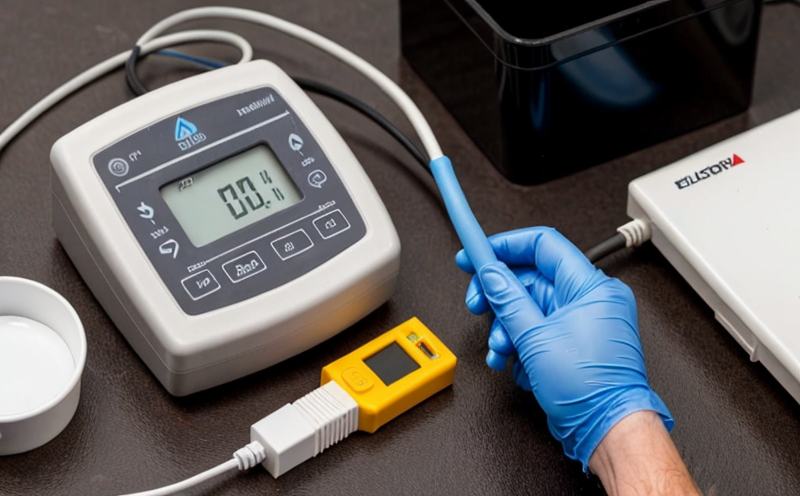DIN EN ISO 15711 Electrochemical Testing of Organic Coatings
The DIN EN ISO 15711 standard provides a robust framework for conducting electrochemical testing on organic coatings to evaluate their resistance against corrosion. This method is essential in sectors such as automotive, aerospace, and marine engineering where the integrity and longevity of protective coatings are critical.
Electrochemical testing involves measuring the current density at specific points on the coating using a three-electrode system: a reference electrode, a counter/reference electrode pair, and the specimen itself. This process allows for the quantification of galvanic corrosion rates, which is crucial in understanding how well a coating can protect the underlying metal from degradation.
The standard specifies detailed procedures to ensure accurate results, including calibration methods, electrode positioning, and environmental controls. The testing procedure typically involves immersing the coated specimen in an electrolyte solution under controlled conditions for a specified period of time. During this process, corrosion cells form on the coating, and their activity is measured.
The results are reported in terms of corrosion current density (μA/cm²), which indicates the rate at which the coating is being consumed due to galvanic action with adjacent metals. This metric helps quality managers and engineers assess the effectiveness of different coatings and determine if they meet specified performance criteria.
Proper specimen preparation is critical for accurate results. The surface must be cleaned of any contaminants, oils, or residues that could interfere with the test. After cleaning, the coating thickness should be measured using non-destructive methods to ensure uniformity across specimens. Specimens are then cut to standard sizes and shapes as specified in the standard.
Instrumentation used for this testing includes potentiostats capable of measuring current and voltage accurately. Electrodes must meet specific specifications regarding geometry, material composition, and surface finish to minimize error. The electrolyte solution also needs careful preparation to ensure consistency with the standard's requirements.
The test setup involves placing the specimen in a chamber filled with the electrolyte, with electrodes positioned according to predefined guidelines. Temperature control is necessary to maintain consistent conditions throughout the testing period. After the specified time has elapsed, the specimens are removed, and any corrosion products are cleaned away for further analysis if required.
Post-test evaluation may involve visual inspections or additional tests such as weight loss measurements to confirm the results obtained from electrochemical impedance spectroscopy (EIS), which is often used alongside this method. Reporting typically includes detailed descriptions of test conditions, specimen preparation, and a comprehensive summary of findings including any deviations from expected performance.
Understanding these nuances can help quality managers make informed decisions about material selection and process improvements. By adhering to DIN EN ISO 15711 standards, organizations ensure that their products meet stringent international requirements for corrosion protection.
Scope and Methodology
The scope of DIN EN ISO 15711 encompasses the electrochemical testing methods used to assess the resistance of organic coatings against galvanic corrosion. This involves measuring current density at various points on the coating using a three-electrode system consisting of a reference electrode, a counter/reference electrode pair, and the specimen itself.
- Reference Electrode: Typically made from platinum or silver/silver chloride.
- Counter/Reference Electrode Pair: Also usually platinum or silver/silver chloride.
- Specimen: The coated metal substrate to be tested.
The methodology specifies detailed procedures for setting up the test environment, including temperature control and electrolyte preparation. It also outlines steps for specimen preparation, such as cleaning and measuring coating thickness. After immersion in the electrolyte solution, the specimens are subjected to a specified duration of exposure under controlled conditions.
During this period, galvanic corrosion cells form on the coating surface, generating measurable currents that indicate the rate of corrosion. Post-test evaluation involves removing the specimens from the electrolyte and cleaning off any corrosion products for further analysis if required. Reporting should include descriptions of all test parameters, including environmental conditions, electrode positioning, and a summary of results.
This standardized approach ensures consistent and reliable data across different laboratories and testing facilities, facilitating comparisons between various coatings and materials.
Industry Applications
- Aerospace: Ensuring the longevity and integrity of protective coatings used in aircraft structures exposed to harsh environmental conditions.
- Automotive: Evaluating the effectiveness of anti-corrosion treatments on vehicle components like exhaust systems, fuel tanks, and body panels.
- Marine Engineering: Assessing the performance of coatings applied to ship hulls and other marine structures subjected to saltwater corrosion.
- Construction: Testing coatings used in infrastructure projects exposed to atmospheric conditions that can lead to rust and deterioration over time.
- Electrical Equipment: Investigating the resistance of insulation materials against internal corrosion within electrical devices.
In each application, electrochemical testing plays a vital role by providing quantitative data on how well coatings perform under real-world conditions. This information is invaluable for improving product designs and ensuring compliance with regulatory standards.
Eurolab Advantages
At Eurolab, we offer comprehensive DIN EN ISO 15711 electrochemical testing services tailored to meet the needs of various industries. Our team of experts ensures that all tests are conducted in strict adherence to international standards.
- Accurate Results: We use state-of-the-art instrumentation and calibrated electrodes to provide precise measurements.
- Compliance Assurance: Our testing aligns with the latest versions of DIN EN ISO 15711, ensuring compliance with international standards.
- Expertise: Our team comprises highly skilled professionals with extensive experience in electrochemical testing.
- Custom Solutions: We offer customized testing protocols to suit specific project requirements.
- Comprehensive Reporting: Detailed reports are provided, including all test parameters and results, facilitating informed decision-making.
By leveraging our expertise and resources, Eurolab helps ensure that your products meet the highest quality standards and perform reliably in challenging environments.





